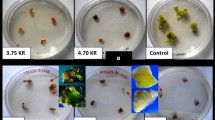Summary
Oenothera plants homozygous for a recessive plastome mutator allele (pm) showed spontaneous mutation frequencies for plastome genes that are 200-fold higher than spontaneous levels. Mutations occurred at high frequencies in plants grown in the field, in a glass-house, or as leaf tip cultures under fluorescent light, indicating that the plastome mutator activity is UV-independent. However, the chlorotic sectors became visible at an earlier stage of development when seedlings were irradiated, compared to seedlings that were not exposed to UV. These results imply that the rate of sorting-out was increased by the irradiation treatment, possibly due to a decrease in the effective number of multiplication-competent plastids, or a reduction in the extent of cytoplasmic mixing. Nitroso-methyl urea treatment of seeds had a dramatic effect on mutation frequency in both wild-type and plastome mutator samples. When the background mutation rates were low, the combination of the plastome mutator nucleus and the chemical mutagenesis treatment resulted in a synergistic effect, suggesting that the plastome mutator may involve a cpDNA repair pathway.
Similar content being viewed by others
References
Ahne A, Muller-Derlich J, Merlos-Lange AM, Kanbay F, Wolf K, Lang BF (1988) Two distinct mechanisms for deletion in mitochondrial DNA of Schizosaccharomyces pombe mutator strains. J Mol Biol 202:725–734
Backer J, Foury F (1985) Repair properties in yeast mitochondrial mutators. Curr Genet 10:7–13
Börner T, Sears BB (1986) Plastome mutants. Mol Biol Rep 4:69–92
Cella R, Iadarola P (1983) Characterization of carrot cell lines resistant to 5-methyltryptophan obtained by irradiating suspension cultures with UV light. Plant Sci Lett 29:327–337
Chiu W-L, Johnson EM, Kaplan SA, Blasko K, Wolfson R, Sokalski MK, Sears BB (1990) Oenothera chloroplast DNA polymorphisms associated with plastome mutator activity. Mol Gen Genet 221:59–64
Del Giudice L, Massardo DR, Manna F, Wolf K (1986) Isolation and characterization of a conditional mutant in Saccharomyces cerevisiae producing rho° peptites at the nonpermissive temperature. Curr Genet 121:201–204
Epp M (1973) Nuclear gene-induced plastome mutations in Oenothera hookeri. I. Genetic analysis. Genetics 75:465–483
Epp MD, Parthasarthy MV (1987) Nuclear gene-induced plastome mutations in Oenothera hookeri. II. Phenotype description with electron microscopy. Am J Bot 74:143–151
Foury F, Kolodynski J (1983) Pif mutation blocks recombination between mitochondrial rho+ and rho− genomes having tandemly arrayed repeat units in Saccharomyces cerevisiae. Proc Natl Acad Sci USA 80:5345–5349
Foury F, Van Dyck E (1985) A PIF-dependent recombinogenic signal in the mitochondrial DNA of yeast. EMBO J 4:3525–3530
Genga A, Bianchi L, Foury F (1986) A nuclear mutant of Sacharomyces cerevisiae deficient in mitochondrial DNA replication and polymerase activity. J Biol Chem 261:9328–9332
Hagemann RF (1982) Induction of plastome mutations by nitrosourea compounds. In: Edelman M, Hallick R, Chua N-H (eds) Methods in chloroplast molecular biology. Elsevier, Amsterdam, pp 119–127
Hagemann RF (1986) A speical type of nucleus-plastid interaction: nuclear gene-induced plastome mutations. In: Akoyunoglou G, Senger H (eds) Regulation of chloroplast differentiation. Liss, NY, pp 455–466
Harris EH (1989) The Chlamydomonas source book. Academic Press, San Diego, p 780
Hosticka LP, Hanson MR (1984) Induction of plastid mutations in tomatoes by nitrosomethylurea. J Hered 75:242–246
Ikenaga M, Mabuchi T (1966) Photoreactivation of endosperm mutations induced by ultraviolet light in maize. Radiat Bot 6:165–169
Johnson EM, Schnabelrauch LS, Sears BB (1991) A plastome mutation affects processing of both chloroplast and nuclear DNA-encoded plastid proteins. Mol Gen Genet 225:106–112
Kumura K, Sekiguchi M (1984) Identification of the uvrD gene product of Escherichia coli as DNA helicase II and its induction by DNA-damaging agents. J Biol Chem 259:1560–1565
Lindahl T, Sedgwick B, Sekiguchi M, Nakabeppu Y (1988) Regulation and expression of the adaptive response to alkylating agents. Annu Rev Biochem 57:133–157
Linne von Berg G (1990) Die Lokalisation der Gene für den Plastommutator (pm) und die Selbstinkompatibilität (Si) in Sippen der Subsektion Evoenothera. PhD Thesis, University of Düsseldorf, Federal Republic of Germany
McCabe PF, Timmons AM, Dix PJ (1989) A simple procedure for the isolation of streptomycin-resistant plants in Solanaceae. Mol Gen Genet 216:132–137
McLennan AG (1987) The repair of ultraviolet light-induced DNA damage in plant cells. Mutat Res 181:1–7
Michaelis P (1969) Über Plastiden-Restitutionen (Rückmutatio-nen). Cytologia 34 (Suppl):1–115
Nagata T, Takebe I (1971) Plating of isolated tobacco mesophyll protoplasts on agar medium. Planta 99:12–20
Ohyama K, Pelcher LE, Gamborg OL (1974) The effects of ultraviolet irradiation on survival and on nucleic acids and protein synthesis in plant protoplasts. Radiat Bot 14:343–346
Oppermann T, Hong T-H, Surzycki SJ (1989) Chloroplast and nuclear genomes of Chlamydomonas reinhardtii share homology with Escherichia coli genes for DNA replication, repair and transcription. Curr Genet 15:39–46
Potrykus I (1970) Mutation and Rückmutation extrachromosomale vererbter Plastidenmerkmale von Petunia. Z Pflanzenzucht 63:24–40
Redei GP, Plurad SB (1973) Hereditary structural alterations of plastids induced by a nuclear gene in Arabidopsis. Protoplasma 77:361–380
Robberecht R, Caldwell MM (1978) Leaf epidermal transmittance of ultraviolet radiation and its implications for plant sensitivity to ultraviolet-radiation induced injury. Oecologia 32:277–287
Sargentini NJ, Smith KC (1985) Spontaneous mutagenesis: the roles of DNA repair, replication, and recombination. Mutat Res 154:1–27
Sears BB (1983) Genetics and evolution of the chloroplast. In: Gustafsson P (ed) Stadler Symposium vol 15, University of Missouri Press, Columbia, MO, pp 119–139
Stubbe W, herrmann RG (1982) Selection and maintenance of plastome mutants and interspecific genome/plastome hybrids from Oenothera. In: Edelman M, Hallick R, Chua N-H (eds) Methods in chloroplast molecular biology. Elsevier, Amsterdam, pp 149–165
Tevini M, Iwanzik W, Thoma U (1981) Some effects of enhanced UV-B irradiation on the growth and composition of plants. Planta 153:388–394
Tilney-Bassett RAE (1975) Genetics of variegated plants. In: Birky CW Jr, Perlman PS, Byers TJ (eds) Ohio State University Press, Columbus, OH, pp 268–308
Author information
Authors and Affiliations
Additional information
Communicated by R.G. Herrmann
Rights and permissions
About this article
Cite this article
Sears, B.B., Sokalski, M.B. The Oenothera plastome mutator : effect of UV irradiation and nitroso-methyl urea on mutation frequencies. Molec. Gen. Genet. 229, 245–252 (1991). https://doi.org/10.1007/BF00272162
Received:
Issue Date:
DOI: https://doi.org/10.1007/BF00272162




